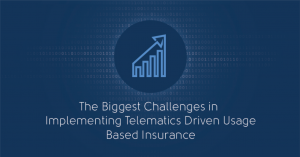
The need for auto insurers to offer a usage-based insurance (UBI) program is well known. According to the Ptolemus Consulting Group, companies that implement a UBI program experience a five percent reduction in average loss ratios. It is no wonder that most of the leading US insurers already have, or are actively piloting, a program.
The need for a UBI program is obvious but that doesn’t mean it’s always easy. In our work helping insurers to implement UBI, we often hear about the internal barriers they face when building a program. The most challenging of these barriers are program cost, program profitability, and integration.
Program Profitability
The total market for usage-based insurance products is a subset – often the most profitable subset – of drivers already in the market. A major draw for these policyholders is the lure of lower premiums, meaning that you may be reducing the margin on your most profitable customers. So why would you bother to implement a UBI program, if you’re harming profitability?
A well-designed usage-based insurance program will invariably help your company attract new customers. The new customer base attracted through a UBI program benefits from positive selection – only people who believe they are good drivers and will be rewarded with premium discounts tend to self-select into such a program. Telematics also allows prospective customers, perhaps policyholders with a competitor, to try the program before opting-in. The driver can start transmitting data to your company via a telematics device and decide whether to switch insurers once their driving behavior has determined their premium. This method of attracting customers reduces their barrier to switching insurers and helps you attract new, safer customers.
Usage-based insurance programs can also help evangelize customers. A 2015 study from J.D. Power shows that drivers who received a discount from participating in a UBI program realized an 11% increase in their likelihood to recommend their insurer to a friend.
Finally, because policyholders in a UBI program are aware they are being monitored, and that their premium depends on good driving behavior, drivers tend to adopt safer driving habits. These combined policyholder attributes lead to a lower-risk customer pool, reduced claims costs, and improved profitability for your company.
Want to Learn More About Integrating UBI and Telematics Programs? Download our Report
With auto insurance seen by many customers as a commodity product, customer retention is a major industry issue. Insurers without a telematics-driven usage-based insurance program face an even greater challenge: the prospect of losing a significant portion of the policyholders at the lower end of their risk pool. While losing customers is a challenge, losing your best customers is truly daunting.
As mentioned above, a usage-based insurance program can be imperative to attracting new customers. Buy how can it improve retention?
Also according to J.D. Power’s study, customer satisfaction improves for drivers who receive premium discounts for participating in a UBI program. This improved customer satisfaction leads directly to improved retention. The same study from J.D. Power shows a 10% increase in UBI participants’ likelihood to renew with their insurer.
With a trial-based telematics solution, a customer drives around with a telematics device in their car for six months, then returns the device. For this type of solution, current customers who opt into a UBI program need to stay with the company for the duration of the trial period before receiving their premium discount. By requiring a trial period prior to offering the discount, insurers can increase the length of the customer lifecycle.
For leave-in telematics solutions, customer engagement becomes central to retention. Companies like Octo provide customer-facing portals that drivers can use to understand their own driving behavior, get tips for improving their driving habits, and see the data impacting their policy premiums. Octo uses a driver score to add an element of gamification to their driver dashboard, helping drivers set improvement goals. Customer-facing technologies like this can help you engage with policy holders, improve customer satisfaction, and increase retention.
Auto insurers are some of the largest advertisers in the United States. To attract and retain customers, their advertising budgets are growing, leading to increased combined ratios. By acquiring new, low risk drivers and increasing customer retention, a UBI program can directly improve company profitability.
Continue reading to learn more about navigating the two other main barriers to success: cost and integration.